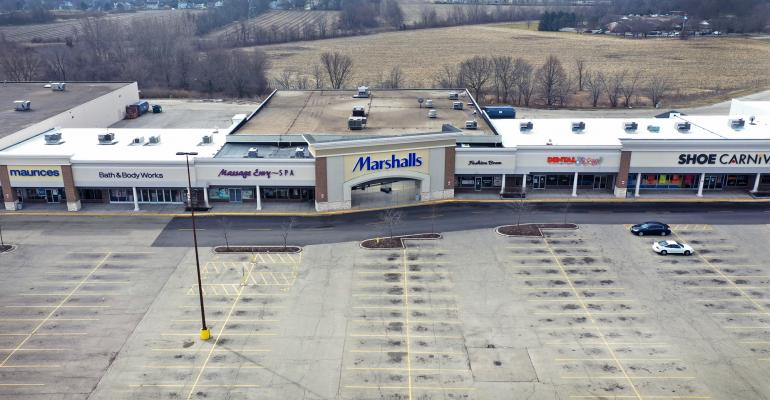While owners of grocery-anchored shopping centers have been able to benefit from the presence of essential retailers like supermarkets and pharmacies at their centers, that hasn’t meant they haven’t been grappling with substantial rent shortages. Multiple shopping center tenants have been trying to renegotiate their rents over the past few months, with mom-and-pop operators facing particularly challenging times.
“Many, if not most tenants, sought some form of rent relief or lease modification in response to COVID-19,” says Phil Voorhees, vice chairman at real estate services firm CBRE. However, “it varies tenant to tenant as to whether these are short-term or long-term modifications,” he notes.
Rent collections at neighborhood grocery-anchored shopping centers averaged in the high 60 percent to a low 70 percent range from March through May, which was above the figures reported by centers without grocery anchors. When grocery stores anchors were taken out of the equation, collections for the same period generally averaged around 50 percent or less, says Voorhees.
“If it’s an essential retailer, they’re performing really well. If it’s a pharmacy or an urgent care facility, they’re still continuing to perform very well,” notes a spokesman for shopping center REIT Kimco Realty. “On the flip side, if it’s a non-essential use, they’re the ones who really have been struggling to get through the environment. Now, what we have seen though, in areas where they’re easing shelter-in-place and restrictions and starting to reopen the economy, there has been a tremendous pent-up demand for people to get out there and start to patronize these retailers and tenants again. So, that’s encouraging for us, it’s given us some cautious optimism.”
Kimco Realty received rent deferral requests totaling approximately 35 percent of its pro-rata minimum base rent for April. Kimco is selectively permitting deferrals for 14 percent of the minimum base rent for this period and is negotiating for payment of the residual April rent not yet collected.
Most tenants forced to close due to COVID-19 struck a deal for a three- to four-month period of rent deferral, generally agreeing to start paying rent back in 2021, says Voorhees.
“We’re really offering deferrals to tenants that seem to be struggling [and] not as well capitalized as compared to some of the large national tenants that have the capacity to pay. Even if [the large national tenants] are closed, we’re still requiring that they still pay their rent,” according to the Kimco spokesperson. “This allows us to be able to help those smaller mom-and-pop type shops and try to give them any kind of life-line we can to help them out.”
All of Kimco’s shopping centers have remained operational, with approximately 56 percent of the company’s tenants currently open, including some that are operating on a limited basis. About 43 percent of the company’s tenants are deemed to be essential.
Shopping center REIT Regency Centers reported that 416 of its properties were operational in the first quarter amid the virus outbreak. But due to social distancing mandates and other COVID-related restrictions, 40 percent of the REIT's tenants were closed as of April. Through May 5, 2020, 62 percent of April 2020 pro-rata base rents were collected, according to Regency Centers.
Jesse Shannon, chief investment officer with Branch Properties, a private real estate investment firm, says the majority of the tenants at Branch shopping centers feel operations will be impacted not only in the near term, but over the next several years. For this reason, tenants are re-evaluating business models in order to operate profitably for the foreseeable future, he notes.
“Given the fact that the Branch Properties portfolio is concentrated in the Southeastern U.S. where most of the states have reopened, we have seen and continue to project for our tenants a dramatic increase in customer traffic and corresponding sales growth from the low point in April,” says Shannon. "That being said, we're anticipating a spike in the infection rates associated with COVID-19 in the fall and a corresponding trough in shopping center visits. As a result of this assumption, Branch Properties continues to reserve cash in anticipation of providing a second round of necessary tenant relief.”
In a typical neighborhood shopping center, where a grocery anchor accounts for between 45,000 sq. ft. to 50,000 sq. ft. of GLA and junior anchors for another 15,000 sq. ft. to 20,000 sq. ft., the grocery store would account for about 47 percent of the center’s income, while smaller tenants would be responsible for a little more than 30 percent, according to Voorhees. The outsized impact of COVID-related closings on the smaller tenants, including restaurants, service providers and some medical offices, has accounted for the dramatic negative fallout for shopping center rents, he notes.
“Unquestionably, several tenants will be forced to renegotiate the terms of their respective leases in a post-COVID-19 world,” says Shannon. “Large-concept restaurants, movie theaters and gyms, for example, that rely on a concentration of customers in order to meet necessary sales hurdles, will be forced to modify their business models and corresponding rent to account for a reduction in patrons.”
Voorhees adds that local mom-and-pop tenants and regional retailers have been the hardest hit, will take the longest to recover and will likely experience the highest rate of store closings.




